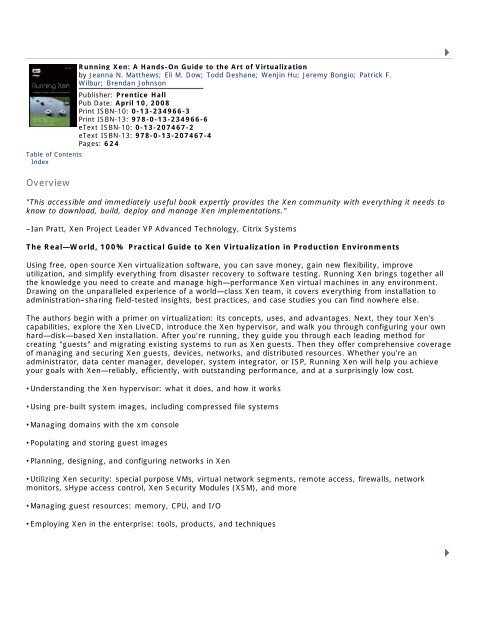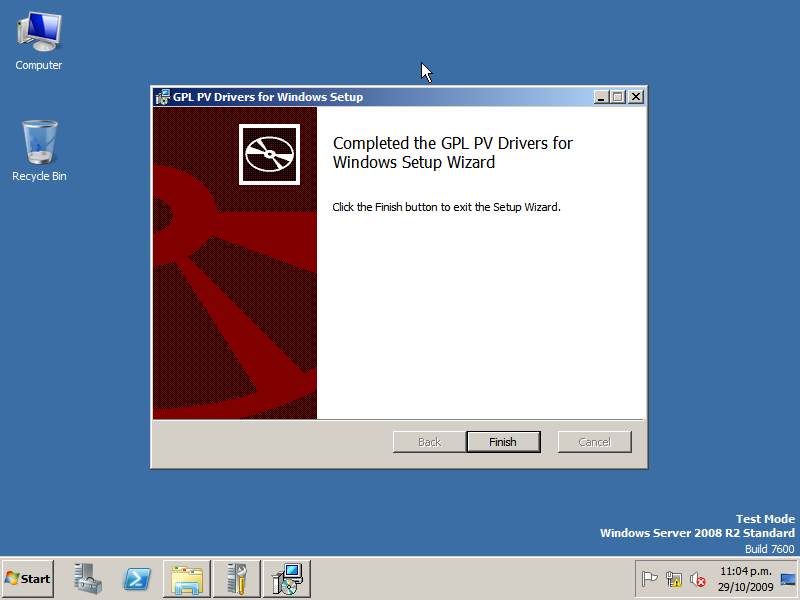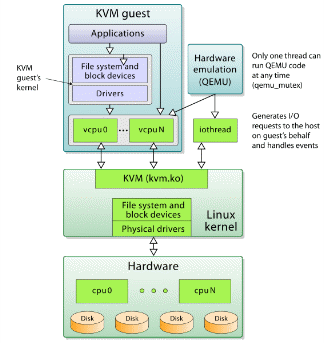- Download Xen Gpl Pv Driver Developers Motherboards Driver Windows 7
- Download Xen Gpl Pv Driver Developers Motherboards Driver 64-bit
- Download Xen Gpl Pv Driver Developers Motherboards Drivers
- Download Xen Gpl Pv Driver Developers Motherboards Drivers
- Download Xen Gpl Pv Driver Developers Motherboards Driver Download
- Download Xen Gpl Pv Driver Developers Motherboards Driver Windows 10
| Needs Review Important page: Some parts of page are out-of-date and needs to be reviewed and corrected! |
To install the drivers, find the Xen PCI driver (probably an Unknown Device in Device Manager) and install from the directory where you put the compiled drivers. After the PCI driver installs, everything under /device will be enumerated (eg vbd, vif, etc), again as 'Unknown Device'. There is only currently a driver for vbd. Install that the. HVM with PV drivers: HVM extensions often offer instructions to support direct calls by a PV driver into the hypervisor, providing performance benefits of paravirtualized I/O; PVHVM: HVM with PVHVM drivers. PVHVM drivers are optimized PV drivers for HVM environments that bypass the emulation for disk and network IO. They additionally make use.
Xen is a virtual machine monitor for x86 that supports execution of multiple guest operating systems with unprecedented levels of performance and resource isolation. This package contains the control tools that allow you to start, stop, migrate, and manage virtual machines. In addition to this package you need to install xen and xen-libs to use. 10.3 The TPM Driver 183. 10.4 Native Hardware 184. 10.5 Adding a New Device Type 187. Part III: Xen Internals 195. Chapter 11: The Xen API 197. 11.1 XML-RPC 198. 11.2 Exploring the Xen Interface Hierarchy 200. 11.3 The Xen API Classes 201. 11.4 The Function of Xend 206. 11.5 Xm Command Line 208. 11.6 Xen CIM Providers 209. The Windows PV Drivers are built individually into a tarball each. To install a driver on your target system, unpack the tarball, then navigate to either the x86 or x64 subdirectory (whichever is appropriate), and execute the copy of dpinst.exe you find there with Administrator privilege.
About
These drivers allow Windows to make use of the network and block backend drivers in Dom0, instead of the virtual PCI devices provided by QEMU. This gives Windows a substantial performance boost, and most of the testing that has been done confirms that. This document refers to the new WDM version of the drivers, not the previous WDF version. Some information may apply though.
I was able to see a network performance improvement of 221mbit/sec to 998mb/sec using iperf to test throughput. Disk IO, testing via crystalmark, improved from 80MB/sec to150MB/sec on 512-byte sequential writes and 180MB/sec read performance.
With the launch of new Xen project pages the main PV driver page on www.xenproject.org keeps a lot of the more current information regarding the paravirtualization drivers.
Supported Xen versions
Gplpv >=0.11.0.213 were tested for a long time on Xen 4.0.x and are working, should also be working on Xen 4.1.
Gplpv >=0.11.0.357 tested and working on Xen 4.2 and Xen 4.3 unstable.
05/01/14 Update:
The signed drivers from ejbdigital work great on Xen 4.4.0. If you experience a bluescreen while installing these drivers, or after a rebootafter installing them, please try adding device_model_version = 'qemu-xen-traditional'. I had an existing 2008 R2 x64 system that consitently failed with a BSOD afterthe gpl_pv installation. Switching to the 'qemu-xen-traditional' device model resolved the issue. However, on a clean 2008 R2 x64 system, I did not have to makethis change, so please bear this in mind if you run into trouble.
I do need to de-select 'Copy Network Settings' during a custom install of gpl_pv. Leaving 'Copy network settings' resulted in a BSOD for me in 2008R2 x64.
I run Xen 4.4.0-RELEASE built from source on Debian Jessie amd64.
PV drivers 1.0.1089 tested on windows 7 x64 pro SP1, dom0 Debian Wheezy with xen 4.4 from source and upstream qemu >=1.6.1 <=2.0.
Notes: - upstream qemu version 1.6.0 always and older versions in some cases have critical problem with hvm domUs not related to PV drivers. - if there are domUs disks performance problem using blktap2 disks is not PV drivers problem, remove blktap2 use qdisk of upstream qemu instead for big disks performance increase (mainly in write operations)
Supported Windows versions
In theory the drivers should work on any version of Windows supported by Xen. With their respective installer Windows 2000 and later to Windows 7, 32 and 64-bit, also server versions. Please see the release notes with any version of gpl_pv you may download to ensure compatibility.
I have personally used gpl_pv on Windows 7 Pro x64, Windows Server 2008 x64, Windows Server 2008 R2 x64 and had success.
Recently I gave Windows 10 a try under Xen 4.4.1 (using Debian Jessie). The paravirtualization drivers still work. The drivers have not been installed from scratch but have been kept during the Windows Upgrade from Windows 7 to Windows 10.
Building
Sources are now available from the Xen project master git repository:
In addition you will need the Microsoft tools as described in the README files. The information under 'Xen Windows GplPv/Building' still refers to the old Mercurial source code repository and is probably dated.
Downloading
New, Signed, GPL_PV drivers are available at what appears to be the new home of GPL_PV athttp://www.ejbdigital.com.au/gplpv
These may be better than anything currently available from meadowcourt or univention.
Older binaries, and latest source code, are available from http://www.meadowcourt.org/downloads/
- There is now one download per platform/architecture, named as follows:
- platform is '2000' for 2000, 'XP' for XP, '2003' for 2003, and 'Vista2008' for Vista/2008/7
- arch is 'x32' for 32 bit and 'x64' for 64 bits
- 'debug' if is build which contains debug info (please use these if you want any assistance in fixing bugs)
- without 'debug' build which contains no debug info
Signed drivers
Newer, signed, GPL_PV drivers are available at what appears to be the new home of GPL_PV at http://www.ejbdigital.com.au/gplpv

You can get older, signed, GPLPV drivers from univention.
Signed drivers allow installation on Windows Vista and above (Windows 7, Windows Server 2008, Windows 8, Windows Server 2012) without activating the testsigning.
Installing / Upgrading
Once built (or downloaded for a binary release), the included NSIS installer should take care of everything. See here for more info, including info on bcdedit under Windows 2008 / Vista.

/! Please definitly visit the link above which links to /Installing . It holds information to not crash your Installation. It concerns the use of the /GPLPV boot parameter.
Using
Previous to 0.9.12-pre9, '/GPLPV' needed to be specified in your boot.ini file to activate the PV drivers. As of 0.9.12-pre9, /NOGPLPV in boot.ini will disable the drivers, as will booting into safe mode. With 'shutdownmon' running, 'xm shutdown' and 'xm reboot' issued from Dom0 should do the right thing too.
In your machine configuration, make sure you don't use the ioemu network driver. Instead, use a line like:
vif = []
Also fixed MAC address can be set,useful to the risk of reactivation of a license for Windows.
Known Issues
This is a list of issues that may affect you, or may not. These are not confirmed issues that will consistently repeat themselves. An issuelisted here should not cause you to not try gpl_pv in a safe environment. Please report both successes and failures to the mailing list, it all helps!
- An OpenSolaris Dom0 is reported not to work, for reasons unknown.
- Checksum offload has been reported to not work correctly in some circumstances.
- Shutdown monitor service in some cases is not added, and must be added manually.
- Network is not working after restore with upstream qemu, workaround for now is set fixed mac address in domUs xl cfg file.
- Installing with 'Copy Network Settings' may result in a blue screen.
- A blue screen may result if you are not using the traditional qemu emulator.
PLEASE TEST YOUR PERFORMANCE USING IPERF AND/OR CRYSTALMARK BEFORE ASSUMING THERE IS A PROBLEM WITH GPL_PV ITSELF
Note: I was using pscp to copy a large file from another machine to a Windows 2008 R2 DomU machine and was routinely only seeing 12-13MB/sec download rate. I consistentlyhad blamed windows and gpl_pv as the cause of this. I was wrong! Testing the network interface with iperf showed a substantial improvement after installing gpl_pv and thedisk IO showed great performance when tested with CrystlMark. I was seeing a bug in pscp itself. Please try to test performance in a multitude of ways before submittinga complaint or bug report.
Using the windows debugger under Xen
Set up Dom0
Download Xen Gpl Pv Driver Developers Motherboards Driver Windows 7
- Change/add the serial line to your Windows DomU config to say serial='pty'
- Add a line to /etc/services that says 'windbg_domU 4440/tcp'. Change the domU bit to the name of your windows domain.
- Add a line to /etc/inetd.conf that says 'windbg_domU stream tcp nowait root /usr/sbin/tcpd xm console domU'. Change the domU bit to the name of your domain. (if you don't have an inetd.conf then you'll have to figure it out yourself... basically we just need a connection to port 4440 to connect to the console on your DomU)
- Restart inetd.
Set up the machine you will be debugging on - another Windows machine that can connect to your Dom0 from.
Download Xen Gpl Pv Driver Developers Motherboards Driver 64-bit
- Download the windows debugger from Microsoft and install.
- Download the 'HW Virtual Serial Port' application from HW Group and install. Version 3 appears to be out, but i've only ever used 2.5.8.
Download Xen Gpl Pv Driver Developers Motherboards Drivers
Boot your DomU
- xm create DomU (or whatever you normally use to start your DomU)
- Press F8 when you get to the windows text boot menu and select debugging mode, then boot. The system should appear to hang before the splash screen starts
Start HWVSP
- Start the HW Virtual Serial Port application
- Put the IP address or hostname of your Dom0 in under 'IP Address'
- Put 4440 as the Port
- Select an unused COM port under 'Port Name' (I just use Com8)
- Make sure 'NVT Enable' in the settings tab is unticked
- Save your settings
- Click 'Create COM'. If all goes well it shuold say 'Virtual serial port COM8 created' and 'Connected device <hostname>'
Download Xen Gpl Pv Driver Developers Motherboards Drivers
Run the debugger
- Start windbg on your other windows machine
- Select 'Kernel Debug' from the 'File' menu
- Select the COM tab, put 115200 in as the baud rate, and com8 as the port. Leave 'Pipe' and 'Reconnect' unticked
- Click OK
- If all goes well, you should see some activity, and the HWVSP counters should be increasing. If nothing happens, or if the counters start moving and then stop, quit windbg, delete the com port, and start again from 'Start HWVSP'. Not sure why but it doesn't always work the first time.
Debugging
- The debug output from the PV drivers should fly by. If something isn't working, that will be useful when posting bug reports.
- If you actually want to do some debugging, you'll need to have built the drivers yourself so you have the src and pdb files. In the Symbol path, add '*SRV*c:websymbols*http://msdl.microsoft.com/download/symbols;c:path_to_sourcetargetwinxpi386'. change winxpi386 to whatever version you are debugging.
- Actually using the debugger is beyond the scope of this wiki page :)
Download Xen Gpl Pv Driver Developers Motherboards Driver Download
Developers
- xenpci driver - communicates with Dom0 and implements the xenbus and event channel interfaces
- xenhide driver - disables the QEMU PCI ATA and network devices when the PV devices are active
- xenvbd driver - block device driver
- xennet driver - network interface driver
- xenstub driver - provides a dummy driver for vfb and console devices enumerated by xenpci so that they don't keep asking for drivers to be provided.
Download Xen Gpl Pv Driver Developers Motherboards Driver Windows 10

- This topic has 6 replies, 2 voices, and was last updated 8 years, 12 months ago by .
Hi
I install WinpkFilter 3.0 on Windows 2008 r2 64bit. Windows HyperV successfully but when I install WinpkFilter 3.0 on Windows 2008 64bit (32bit & 64bit) bases on Xen VPS i lost my RDP connection to server even after restart. i still can ping the server. server have 1GB ram.I can give you root access to server but i need to reimage server after it stop responding to remote desktop.
The step that reproduce the issue
1) reimage Xen VPS server (Windows 2008 64 and 32 available)
2) download and run WinpkFilter 3.0 from http://www.ntkernel.com/downloads/winpkflt_rtl.zip
3 ) RDP stop working forever
Can it be fixed?Hmm, looks strange, however I had not tested WinpkFilter in XEN VM before. SO several questions:
1) Do you have VLAN enabled interfaces in Windows 2008?
2) Can you check is RDP connection established but dropped or not even established (you can check this using network snifer)? If ping works but another protocol fails it can be MTU (packet size issue), as ICMP packets are very small by default.
3) Can be the system be accessed by any other protocol/port besides RDP?
4) Do you use any WinpkFilter application on the system or just the default driver installation stops the RDP?Please note that internally WinpkFilter driver uses a limited buffer pool used for all packet related operations. So, an example, if you set a network interface into the tunnel mode and won’t read filtered packets from the driver then the number of queued packets grows up to the buffer limit and as soon as the limit is reached the network operations are blocked for all network interfaces (network freeze). So if you expirience the network freeze it is more likely to be a bug in your application. There are many WinpkFilter based applications on the market, and if it would be a kind of hidden bug then you won’t be the only one who expirience this.
By the way, what kind of driver you have installed on your server? NDIS IM or NDIS LWF? Both drivers can be used on WIndows 7, but they are different by architecture. So if you try another one there could be a difference in behaviour. However, if this is application bug then most probably the behaviour would be just the same.
I’ll take a look at Xen as soon as I have time for this. Xen does not seem to be an easy thing to setup and configure. The behavoiur you have reported looks very strange. What WinpkFilter version have you installed on that system? Has the instalaltion went smooth? Network blocking may happen if driver is installed but not loaded (because of signature problems) in x64 Windows. Have you lost the connection immediatly after driver installation? Was you able to reconnect before rebooting? After the reboot? There is a chance that during the installation process the network was already blocked (driver started installing) but Windows still needed some sort of interactive confirmations from you, so the installation has not completed succesfully causing the network getting down.
Why you don’t provide option to bypass packets when the buffer is full?
This is done to prevent packets to bypass filtering. Most of WinpkFilter applications can’t afford passing unfiltered packets. However, this can be done in custom driver build.
Why you don’t provide WinPKFilter to close application capture event handle when it detect application does not response or does not process packets it specific time?
Same reasons as above. Application can be not getting CPU time for some period, but it does not mean that security has to be broken and filtering should be dropped. Filtering is turned off if and driver is reset to default state only if all user mode WinpkFilter clients are terminated.
Is WinPKFilter report it to a log file when such issue happen? How we can find the original reason of such issue?
I don’t see much sense in logging such an event as it does not really provide an information what has happened. Check your code for reading packets from the driver. This is the only way.
